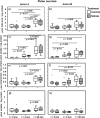Nitrate and the Origin of Saliva Influence Composition and Short Chain Fatty Acid Production of Oral Microcosms
- PMID: 27155967
- PMCID: PMC4937104
- DOI: 10.1007/s00248-016-0775-z
Nitrate and the Origin of Saliva Influence Composition and Short Chain Fatty Acid Production of Oral Microcosms
Abstract
Nitrate is emerging as a possible health benefactor. Especially the microbial conversion of nitrate to nitrite in the oral cavity and the subsequent conversion to nitric oxide in the stomach are of interest in this regard. Yet, how nitrate influences the composition and biochemistry of the oral ecosystem is not fully understood. To investigate the effect of nitrate on oral ecology, we performed a 4-week experiment using the multiplaque artificial mouth (MAM) biofilm model. This model was inoculated with stimulated saliva of two healthy donors. Half of the microcosms (n = 4) received a constant supply of nitrate, while the other half functioned as control (n = 4). Additionally, all microcosms received a nitrate and sucrose pulse, each week, on separate days to measure nitrate reduction and acid formation. The bacterial composition of the microcosms was determined by 16S rDNA sequencing. The origin of the saliva (i.e., donor) showed to be the strongest determinant for the development of the microcosms. The supplementation of nitrate was related to a relatively high abundance of Neisseria in the microcosms of both donors, while Veillonella was highly abundant in the nitrate-supplemented microcosms of only one of the donors. The lactate concentration after sucrose addition was similarly high in all microcosms, irrespective of treatment or donor, while the concentration of butyrate was lower after nitrate addition in the nitrate-receiving microcosms. In conclusion, nitrate influences the composition and biochemistry of oral microcosms, although the result is strongly dependent on the inoculum.
Keywords: Neisseria; Nitrate reduction; Oral microbiome; Short chain fatty acids; Veillonella.
Figures







References
-
- Andersson R. Nitrate reduction during fermentation by Gram-negative bacterial activity in carrots. Int J Food Microbiol. 1985;2:219–225. doi: 10.1016/0168-1605(85)90012-1. - DOI
MeSH terms
Substances
LinkOut - more resources
Full Text Sources
Other Literature Sources
Molecular Biology Databases

